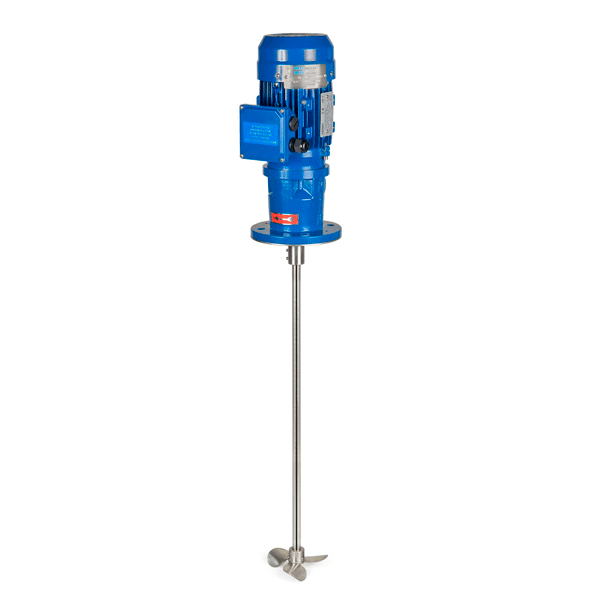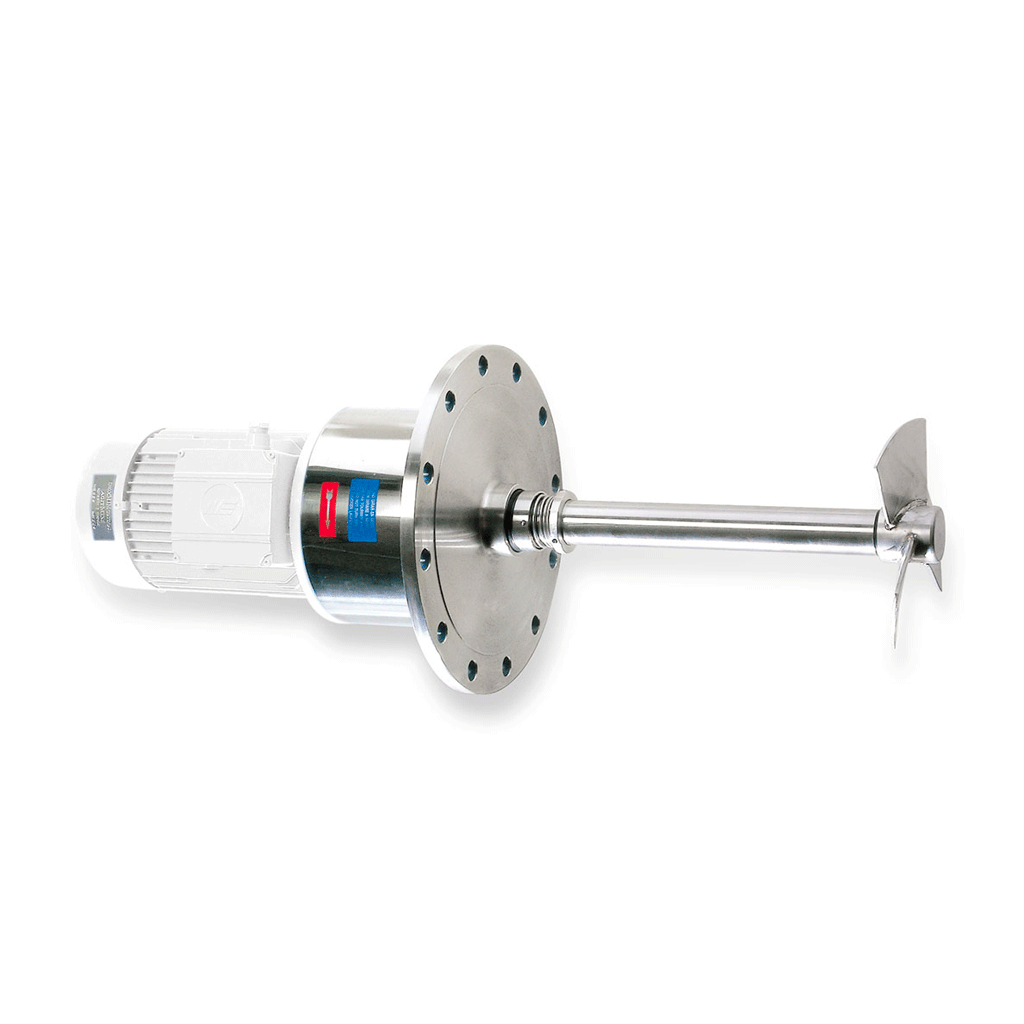How Agitation and Mixing Processes Optimize Production in Pharmaceutical, Cosmetic, and Food Sectors
Agitation and mixing are fundamental processes in many industries, including pharmaceuticals, cosmetics, and food. These processes are not only crucial for the homogenization and integration of ingredients, but they also ensure that the final products meet the required quality standards in terms of both consistency and stability. The correct application of these processes can be the difference between a high-quality product and one that does not meet the desired specifications.
In the cosmetic industry, for example, agitation and mixing are essential for the production of creams, gels, and lotions, where it is necessary to ensure uniform distribution of active ingredients and emulsifiers to guarantee the product’s efficacy.
Table of contents

Similarly, in the food industry, these processes are key to producing sauces, purees, and beverages, where consistency and flavor depend on a homogeneous mixture of ingredients.
From a technical perspective, agitation involves the movement of liquids or mixtures through the motion induced by an agitator, which promotes the mixing of ingredients and heat transfer.
On the other hand, mixing is a broader process that can involve combining solids, liquids, or gases to form a homogeneous mixture.
In many cases, agitation is a step within the mixing process, but this is not always the case. The difference between the two concepts lies in the specific objectives and techniques applied in each case.
The correct implementation of agitation and mixing techniques not only improves the efficiency of industrial processes but also contributes to sustainability by reducing energy consumption and minimizing waste. Therefore, understanding and properly applying these processes is essential for any industrial operation seeking to optimize production and ensure product quality.

Difference Between Agitation and Mixing
Although the terms “agitation” and “mixing” are often used interchangeably, in industrial process engineering, each has a specific meaning and application. Understanding these differences is crucial for selecting the right technology for each process and optimizing production performance.

Agitation refers to the process of inducing movement in a liquid or mixture using an agitator. This movement can be circular, linear, or turbulent, depending on the equipment design and process objectives. Agitation is essential in processes where it is necessary to maintain a homogeneous mixture, prevent the sedimentation of solids, or improve heat transfer within the system. In the cosmetic industry, for example, agitation is used to ensure that active ingredients remain evenly distributed throughout the solution, which is crucial for the efficacy of the final product.
On the other hand, mixing is a broader term that refers to the combination of two or more substances to form a homogeneous mixture. This process can involve the combination of liquids, solids, gases, or any combination of these. The goal of mixing is to achieve a uniform distribution of components throughout the mixture, ensuring that each portion of the final product has the same physical and chemical properties. Mixing is particularly important in the food industry, where the consistency and flavor of products like sauces or purees depend on a uniform mixture of ingredients.
In summary, while agitation focuses on maintaining movement within a fluid to achieve objectives such as homogenization or heat transfer, mixing is centered on combining different materials to form a homogeneous mixture. Both processes are complementary and are often used together in complex industrial operations. For example, in the production of a cosmetic cream, ingredients can first be mixed to form a uniform base and then agitated to ensure the integration of active components or to adjust the product’s texture.
The choice between agitation and mixing, or the combination of both, depends on the characteristics of the material being processed and the desired final outcome. A deep understanding of these processes allows engineers and technicians to select the appropriate equipment and configure operational parameters to maximize efficiency and product quality.
Liquid Agitation and Mixing Processes
The agitation and mixing of liquids are essential processes in various industries, from pharmaceuticals and cosmetics to food and chemicals. These processes enable the manipulation and transformation of liquids to achieve specific characteristics, such as homogeneity, stability, and proper integration of components. The correct implementation of these processes is fundamental to ensuring the final product’s quality and operational efficiency.
Importance of Agitation and Mixing in Liquid Handling
In liquid handling, agitation and mixing are used to fulfill several key functions:
Ensuring that all components of a liquid mixture are evenly distributed is crucial for product consistency. In the pharmaceutical industry, for example, uniformity in the concentration of an active ingredient in a solution is essential to guarantee the medication’s efficacy and safety.
Agitation facilitates heat transfer within a liquid, which is crucial in processes where maintaining a constant temperature or reaching a specific temperature quickly is necessary. This is common in food pasteurization and in reaction processes within the chemical industry.
In mixtures containing suspended solids, agitation prevents the solids from settling at the bottom of the container. This is vital in the production of suspensions and emulsions, where product stability depends on keeping solids evenly dispersed.
Agitation helps dissolve solids in liquids more quickly and efficiently, which is important in formulating products where it is necessary to fully dissolve solid ingredients into a liquid base, such as in the manufacture of syrups or pharmaceutical solutions.
Description of Types of Agitators and Mixers Used in Industry
Industrial agitators and mixers are designed to meet a wide range of operational requirements, depending on the characteristics of the liquid and the process. Some of the most common types of agitation and mixing equipment used in industry include:
Each type of agitator and mixer has its specific applications and is selected based on factors such as liquid viscosity, the need for heat transfer, and the nature of the components being mixed.
Technical Benefits of Proper Liquid Agitation and Mixing
Correctly implementing liquid agitation and mixing processes offers several technical benefits that can enhance production efficiency and quality:
Proper agitation can speed up processes such as dissolution, chemical reactions, or heat transfer, thereby reducing the time required to complete an operation.
By ensuring a homogeneous and uniform mixture, the quality and consistency of the final product are improved, which is especially important in the pharmaceutical and cosmetic industries.
Efficient agitation and mixing equipment are designed to maximize the effectiveness of these processes with minimal energy consumption, contributing to sustainability and reducing operational costs.
Industrial Applications of Agitation and Mixing
Agitation and mixing are fundamental processes in various industries, playing a crucial role in the production of a wide range of products. Below, we explore some of the most common industrial applications and the importance of these processes in each sector.
Cosmetic Industry
In the cosmetic industry, the quality and effectiveness of products largely depend on the homogeneity and stability of formulations. Cosmetic products such as creams, gels, shampoos, and lotions require precise mixing of active ingredients, emulsifiers, oils, and other components. Agitation and mixing in this context ensure that the ingredients are evenly distributed and that the final product’s texture is consistent and pleasant to the touch.
For example, in the production of moisturizing creams, the aqueous and oily phases must be properly emulsified to create a smooth and stable texture. The use of anchor agitators and high-speed mixers is common in these processes, allowing the formation of stable emulsions and preventing phase separation.

Moreover, the cosmetic industry requires that these processes be carried out under hygienic and controlled conditions to avoid product contamination. This makes the choice of agitation and mixing equipment critical, as they must comply with the strictest sanitary regulations and allow for efficient cleaning.
Food Industry

In the food industry, agitation and mixing are essential for preparing products such as sauces, purees, soups, beverages, and dairy products. These processes not only influence the consistency and flavor of the final product but also affect food safety and shelf life.
For example, in the preparation of sauces, agitation is necessary to keep the ingredients in suspension and ensure an even distribution of flavors and seasonings. This is especially important in products like salad dressings, where ingredient separation can negatively impact the consumer experience.
In the case of milk processing, agitation during pasteurization helps ensure that the temperature is uniform throughout the liquid volume, which is crucial for destroying pathogens and ensuring the final product’s safety. The equipment used in these processes must be capable of handling large volumes and operating efficiently under heat and pressure conditions.
Pharmaceutical Industry
In the pharmaceutical industry, precision in mixing and agitation is essential to ensure the quality and safety of medications. These processes are critical in producing intravenous solutions, suspensions, topical creams, and in formulating products where exact dosing and homogeneity of the final product are crucial.
For example, in the production of intravenous solutions, it is vital that the ingredients are completely dissolved and that the solution is homogeneous to avoid dosing issues and ensure product stability. Controlled and precise agitation is key in these processes, and equipment that allows exact control of speed and agitation time must be used.

Furthermore, the pharmaceutical industry requires that agitation and mixing processes be conducted in aseptic conditions to prevent contamination. This demands the use of specialized equipment, such as agitators with mechanical seals that prevent contaminants from entering, and CIP/SIP systems that allow for cleaning and sterilization without the need to disassemble the equipment.
InoxMIM Agitation and Mixing Solutions
InoxMIM has established itself as a leading provider of agitation and mixing solutions, offering a wide range of products designed to meet the specific needs of various industries, including cosmetics, food, and pharmaceuticals. The company combines advanced technology with a deep understanding of industrial processes to create equipment that not only meets technical requirements but also optimizes efficiency and the quality of the final product.
TANDEM Vertical Agitators
InoxMIM’s TANDEM vertical agitators stand out for their ability to handle highly complex applications where efficient and controlled agitation is required. These counter-rotating agitation systems are designed to maximize process efficiency by allowing the use of different sealing systems, enabling them to operate under vacuum or overpressure conditions and at various temperatures.
TANDEM agitators are particularly useful in processes involving high-viscosity liquids or requiring intensive mixing, such as in the production of creams and gels in the cosmetic industry or polymer synthesis in the chemical industry. The robustness and versatility of these agitators make them an ideal solution for processes demanding high precision and consistency.
GFL Vertical Agitators
Another standout solution from InoxMIM is the GFL vertical agitators, designed to adapt to the specific requirements of each system. These agitators are essential in the food, pharmaceutical, cosmetic, and chemical industries due to their ability to handle a wide range of applications, from mixing low-viscosity liquids to dispersing solids in liquids.
GFL agitators can be composed of different agitation elements, allowing them to meet the particular demands of each client. For example, in the food industry, they are ideal for producing sauces and soups, where mixture uniformity is crucial to ensure consistency in flavor and texture. In the pharmaceutical industry, these agitators are used in processes where homogeneity and precision are fundamental, such as in the production of suspensions and sterile solutions.
Other Notable Models
In addition to the TANDEM and GFL agitators, InoxMIM offers a variety of other agitator and mixer models designed to optimize specific processes:
- Propeller Agitators: Ideal for low-viscosity liquids and applications requiring a high heat transfer rate.
- Paddle Agitators: Suitable for medium to high-viscosity liquids, used in processes where mixing denser ingredients is essential.
- High-Speed Mixers: Perfect for producing emulsions and fine dispersions, where rapid and uniform mixing is required.
Each of these models is designed to offer superior performance, ensuring that agitation and mixing processes are carried out efficiently and with the highest quality.
Advantages of Choosing InoxMIM for Agitation and Mixing
Choosing the right equipment for agitation and mixing processes is crucial to ensure efficiency, the quality of the final product, and the optimization of resources in any industrial operation.
InoxMIM, with its extensive experience and commitment to innovation, offers several advantages that make its solutions the ideal choice for various industries.

Contact with us















